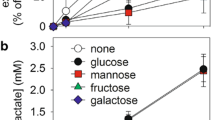Abstract
Selected esters of D-glucose were recently proposed as tools to provide the sugar to cells, whilst bypassing the carrier system for hexose transport across the plasma membrane. In the present study, α-D-glucose pentaacetate, β-D-glucose pentaacetate, α-D-mannose pentaacetate and, to a lesser extent, 6-O-acetyl-D-glucose, all tested at a 1.7 mM concentration, were found to increase lactate production above basal value in rat erythrocytes. Over 90 min incubation, the increment in lactate production ranged from about 1.2 (α-D-glucose pentaacetate) to 0.6 (6-O-acetyl-D-glucose) μmol/μl of erythrocytes. Little or no change in lactate production was observed in cells exposed to β-L-glucose pentaacetate, α-D-glucose pentaethylsuccinate, α-D-galactose pentaacetate or β-D-galactose pentaacetate. The metabolic response to α-D-glucose pentaacetate was resistant to 3-O-methyl-D-glucose (10-80 mM) which suppressed, however, that evoked by D-glucose. D-mannoheptulose (10 mM) virtually failed to affect the response to D-glucose and its pentaacetate ester. On the contrary, 2-deoxy-D-glucose (10.6 mM) inhibited to the same relative extent (55% decrease) lactate production in erythrocytes exposed to either unesterified D-glucose or α-D-glucose pentaacetate. The tetraacetic ester of 2-deoxy-D-glucose was more efficient than unesterified 2-deoxy-D-glucose in inhibiting lactate production from α-D-glucose pentaacetate. It is proposed that selected esters of saccharides represent useful tools to bypass defects in hexose transport, and to increase their nutritional or therapeutic efficiency.
Similar content being viewed by others
References
Unger RH: Diabetic hyperglycemia: Link to impaired glucose transport in pancreatic cells. Science 251: 1200–1205, 1991
Malaisse WJ, Jijakli H, Kadiata MM, Sener A, Kirk O: Stimulation of insulin release by α-D-glucose pentaacetate. Biochem Biophys Res Commun 231: 435–436, 1997
Wolfrom ML, Thompson A: Monosaccharides. D-galactose. In: RL Whistler and ML Wolfrom (eds). Methods in Carbohydrate Chemistry. Academic Press, London, 1962, Vol I, pp 120–122
Ljunger G, Adlecreutz P, Mattiasson B: Lipase catalyzed acylation of glucose. Biotechnology Lett 16: 1167–1172, 1994
Wang Y-F, Lalonde JJ, Momongan M, Bergbeiter DE, Wong C-H: Lipasecatalyzed irreversible transesterification using enol esters as acylating reagents: Preparative enantio-and regio-selective synthesis of alcohols, glycerol derivatives, sugars and organometallics. J Am Chem Soc 110: 7200–7205, 1988
Zinner H, Wessely K, Bock W, Rieckhoff K, Strandt F, Nimmich W: Sugar mercaptals. V. Benzoates and p-nitrobenzoates of aldoses and aldose mercaptals. Chem Ber 90: 500–515, 1957
Zoltán C, Gyula D, László F: Investigation of titanium tetrachloride complexes. Acta Chim Acad Sci.-Hung 21: 169–180, 1959
Vogel A: A Textbook of Practical Organic Chemistry. Longman, Green and Co, London, 1956, 3rd ed, p 383
Manuel o Keenoy B, Malaisse-Lagae F, Malaisse WJ: Metabolism of tritiated D-glucose in rat erythrocytes. Metabolism 40: 978–985, 1991
Malaisse WJ, Lea MA, Malaisse-Lagae F: The effect of mannoheptulose upon the phosphorylation of glucose and the secretion of insulin by islets of Langerhans. Metabolism 17: 126–133, 1968
Malaisse WJ, Sánchez-Soto C, Larrieta ME, Hiriart M, Jijakli H, Viñambres C, Villanueva-Peñacarrillo ML, Valverde I, Kirk O, Kadiata MM, Sener A: Insulinotropic action of α-D-glucose pentaacetate: functional aspects. Am J Physiol 273: E1090–E1101, 1997
Garcia-Martinez JA, Ladrière L, Villanueva-Peñacarrillo ML, Valverde I, Malaisse WJ: Insulinotropic action of α-D-glucose pentaacetate in vivo. Diab Nutr Metab 10: 198–202, 1997
Sener A, Welsh N, Malaisse-Lagae F, Kadiata MM, Malaisse WJ: Insulinotropic action of α-D-glucose pentaacetate. Metabolic aspects. Mol Gen Metab, submitted for publication, 1998
Malaisse WJ, Kirk O: Insulinotropic action of 6-O-acyl-D-glucose esters. Horm Metab Res, in press, 1998
Sener A, Levy J, Malaisse WJ: The stimulus-secretion coupling of glucose-induced insulin release. XXIII. Does glycolysis control calcium transport in the B-cell? Biochem J 156: 521–525, 1976
Delvaux A, Kadiata MM, Malaisse WJ: Cytotoxicity of 2-deoxy-Dglucose and its tetra-acetate ester in tumoral cell lines. Oncol Rep 4: 1295–1299, 1997
Author information
Authors and Affiliations
Rights and permissions
About this article
Cite this article
Ladrière, L., Kadiata, M.M., Kirk, f. et al. Stimulation by hexose esters of lactate production by rat erythrocytes, insensitivity to 3-O-methyl-D-glucose and inhibition by 2-deoxy-D-glucose and its tetraacetic ester. Mol Cell Biochem 183, 175–182 (1998). https://doi.org/10.1023/A:1006838425328
Issue Date:
DOI: https://doi.org/10.1023/A:1006838425328




